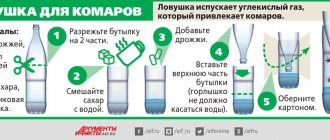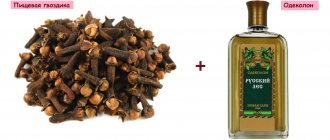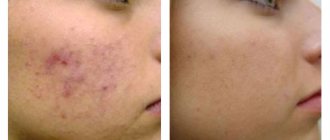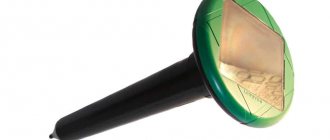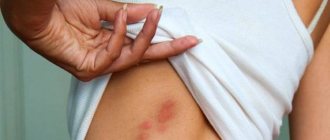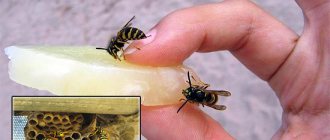Stung by a bee or wasp?
Many of us in childhood could not distinguish a bee from a wasp, and this is very important, since first aid for their bites is somewhat different. Well, let's fill this gap and highlight the main differences
these insects.
· Bees
They attack only when they sense danger from a person; in other words, they
defend themselves
.
But wasps are annoying
: they don’t need any reason to sting.
· A bee stings only once in its entire life.
, since its jagged sting gets stuck in the skin and comes off, which provokes the death of the bee.
A wasp can sting many times
because it has a smooth sting that does not break and easily comes out of a person’s skin.
· Wasps sting more painfully
bees
· The round body of a bee is covered with villi and has a muted color, while the body of wasps is smooth, elongated and has a bright color.
· Bees only eat pollen
, while the diet of wasps is very diverse.
Bite symptoms
· Sharp pain and burning at the bite site
· The appearance of edema, which may progress
Redness of the affected area
Formation of a white dot at the site of penetration of a bee or wasp sting
· Development of an allergic reaction, manifested by hives, cough, difficulty breathing, nausea, vomiting, chills, swelling of soft tissues, a sharp decrease in blood pressure, fever, dizziness, loss of consciousness.
Bitten by a bee (wasp): first aid
Most often, bee and wasp stings do not pose a serious danger to human life. But if an insect stings a child or a person suffering from allergies, then to avoid serious negative consequences it is necessary to competently provide first aid to the victim.
1. Carefully remove the tip
without squeezing it out. It is best to use tweezers for these purposes; in this case, the bite site and the instrument itself should first be disinfected with any alcohol solution; in the absence of which, the affected area should be washed with clean water. If you are stung by a bee, then in the process of pulling out the sting, it is advisable not to damage the small bag of poison attached to the sting shaft.
2.
After removing the sting,
disinfect the wound
with alcohol, iodine, brilliant green, hydrogen peroxide or regular soap.
How to neutralize wasp venom
When a bite does occur, but it is not known in advance how a person will react to the wasp’s venom, you should act very quickly. First of all, it is important to remember what you should never do, namely:
- Drink alcohol, as alcohol accelerates the absorption of poison into the blood;
- Cool the bite with water from a nearby pond or earth, clay, as you can get a dangerous infection, including tetanus;
- Press on the bite, as this helps spread the poison;
- Kill the insect, as this releases odorous substances into the air, notifying all nearby wasps about the attack. As a result, instead of one insect, a whole swarm can attack at once.
To disinfect a bite use:
- Alcohol;
- Hydrogen peroxide;
- Alcohol tinctures of calendula, propolis, etc.;
- A weak solution of potassium permanganate;
- Ammonia.
The following will help reduce intoxication:
- Antihistamines: Suprastin, Loratadine, etc.;
- A cooling compress of ammonia or ice.
Important! In case of multiple bites, you should call an ambulance, since it is impossible to predict the body’s reaction to a large dose of wasp venom.
So, what you shouldn’t do if you’ve been bitten by a wasp is panic. You need to act quickly and try to get to the hospital as soon as possible. If we are talking about an allergy sufferer or a child, then it is better to immediately give medicine for the allergy. Wasp venom should not be used as a cure for any disease.
What not to do when bitten by bees and wasps
1. Kill or injure a stung bee
, which in such a situation releases substances that cause aggression of the entire swarm. And this threatens a massive bee attack.
2. Rub or comb
bite site, otherwise the poison may enter neighboring tissues, which significantly increases the risk of infection.
3. Press on the bite site
, trying to remove the sting (this will help prevent the spread of infection).
4. Drink alcohol
, dilates blood vessels and opens the way for the spread of poison.
5. Take sleeping pills
, enhancing the effects of the poison.
Bee sting to the head
Bee or wasp sting to the face
may cause pain and may lead to severe swelling, allergic reactions and suffocation.
Moreover, if you are stung by more than three individuals, a toxic reaction
. The fact is that bee venom in such quantities is very toxic and can lead to a noticeable deterioration in health.
The most dangerous bites are on the lip, tongue or larynx.
: in these cases, the resulting swelling can spread to the entire larynx, which can cause suffocation. Therefore, in such cases, you should immediately call an ambulance.
Bee sting on the lip
If a bee or wasp bites your lip
, then you need to urgently seek help from a doctor.
In order to alleviate the condition of the victim, you should first of all treat the damaged area with a soap solution.
You can also use a face toner without alcohol, since
alcohol increases tissue swelling.
Next, we remove the sting and disinfect the bite site, after which we take an antihistamine.
A stung lip will quickly swell, which is not something to be afraid of. The swelling will go down in a day or two. But still compresses with chamomile, green tea or aloe vera
will not interfere as a sedative, analgesic and decongestant.
Bee sting in the eye
The eye is a very sensitive organ that reacts to any external influence with a pronounced reaction. And a bee or wasp sting is no exception.
Danger of being bitten in the eye
It also lies in the fact that it is located close to the main mucous membranes, as a result of which the swelling of the eyelid can affect other areas of the face and neck, thereby causing not only blurred vision, but also suffocation.
Signs of a bite to the eye:
sharp pain
redness of the eyelid
· burning sensation
· profuse tearing
inflammation of the mucous membrane of the eye and eyelid (up to the development of panophthalmitis)
Closure of the palpebral fissure.
Peak swelling of the eyelid is observed the day after the bite. In addition, swelling, itching and pain appear in the eyes
, tear production becomes difficult,
vision deteriorates
. The listed symptoms can be observed for 2 to 10 days.
In severe cases, mucopurulent discharge and even destruction of the sclera may be observed, not to mention the development of such serious diseases as cataracts and glaucoma
.
First aid for a bite in the eye is no different from the measures taken if a wasp or bee stings anywhere else on the body.
But!
If you are bitten in the eye, you need to act with extreme caution, and after removing the sting, you must definitely consult a doctor, which will help prevent the development of complications.
Bee sting on the neck
A bite to the neck area is characterized by severe swelling and inflammation of nearby lymph nodes, as well as the appearance of nagging pain not only at the site of the bite, but also directly in the lymph nodes.
Swelling, like redness, lasts on the skin from one to ten days.
The main danger of a bite to the neck
– the possibility of swelling of the larynx, which can lead to respiratory arrest and death. Therefore, it is extremely important to competently provide first aid and take the victim to the hospital.
At home, traditional medicine recipes will help relieve swelling.
Onion:
the bulb is cut in half and applied with the cut to the site of swelling.
Collection of herbs
plantain, dandelion and parsley, which are taken in equal proportions and passed through a juicer, after which cotton swabs are soaked in the resulting juice, which are frozen and then applied to the swollen areas of the skin.
Raw potatoes
, which should be grated, and the resulting pulp should be applied to the bite site for 10 minutes.
How to avoid becoming a victim of a wasp
If you are careful and act according to certain rules, you can not only avoid an insect attack, but also minimize the consequences of its attack:
- When in the forest or in nature, you should not climb and stir up the nests of any insects, not just wasps
- If a wasp is circling nearby, then there is no need to wave your arms, because this will certainly provoke an attack of aggression and a defensive reaction in the insect. You should also not hunt wasps or try to kill them. The most rational solution is to calmly move away from the place where the wasp is circling.
If you have to deal with wasp stings, you need to immediately take measures that can be done at home. If the allergy does not go away, you should call a doctor. A wasp sting can be dangerous, so it should never be ignored, much less taken lightly.
Conclusions from Tikhon: It is impossible to predict a wasp sting, unless of course you go into their home yourself. But if you are stung, do not panic, the main thing is to do everything in a timely manner.
If you have experience solving this problem, share it in the comments below. Perhaps he will help someone make the right decision.
Health to you and your loved ones.
What to do if a bee bites a child
Sweets are the favorite treats not only of children, but also of wasps and bees. Therefore, not only adults, but also children often become victims of these stinging insects. What to do if a child is bitten by a bee
?
Fortunately, most children tolerate bee and wasp stings well, but sometimes they have allergic reactions.
varying degrees of severity, characterized by redness of the skin, swelling, pain at the site of the bite, burning and itching.
As with adults, cases are especially dangerous when bees sting in the head area, that is, where the blood vessels are close to the skin.
Then dizziness, fever, vomiting, loss of consciousness and swelling of the larynx are added to the above manifestations of the bite, which is extremely dangerous. In this case, parents must take the child to the hospital!
What to do if you are stung by a bee or wasp?
Firstly,
the sting must be removed.
Secondly,
disinfect the bite site.
Third,
neutralize the effect of the poison.
So, wasp venom causes an alkaline reaction
, so you need to treat the affected area with an acid, for example, lemon juice or aspirin diluted with water until a paste forms.
In addition, aspirin has an analgesic effect, which will ease the child’s condition. But bee venom provokes the development of an acid reaction
, and therefore it must be neutralized with an alkali, namely a soap solution.
Fourthly,
it is necessary to provide the child
with plenty of fluids
, and the liquid consumed should be cold. The fact is that bee venom spreads throughout the body very quickly, and drinking hot drinks will only speed up this process.
You can also relieve pain with ice or an aqueous solution of ammonia (water and ammonia are taken in a ratio of 1:5, respectively).
Do not forget about the weak pink solution of potassium permanganate, in the absence of which you can use a saline solution
, prepared at the rate of one teaspoon of salt per 250 ml of water.
If trouble happens in nature, then you can use plants such as plantain, rhubarb, parsley root
. Under no circumstances should clay, earth or sand come into contact with the wound, this will help prevent infection of the bite site.
Swelling and burning often go away after 1 to 2 hours, but if swelling, itching and redness do not go away within two days, you should consult a doctor to avoid allergies and infection.
Important!
antiallergic medications
with you , which will help reduce the manifestations of allergies.
And further:
do not yell at the baby, on the contrary, try to caress him and calm him down, because he is really in pain, and therefore he may perceive any manipulations to remove the sting and treat the wound negatively.
Folk remedies
People have come up with quite a lot of ways to treat bee and wasp stings. The essence of many recipes is that the wound needs to be lubricated with plant juice as quickly as possible.
The acids contained in it partially neutralize the poison, since it is of a protein nature - a denaturation process occurs.
Suitable for this purpose:
- lemon;
- onion;
- sour apple;
- vinegar;
- bruised sorrel;
- sour berries and so on.
Other ways to provide assistance are shown in the table and video in this article.
Table. Folk remedies to reduce symptoms after a wasp bite:
| Way | A comment |
| Mash the leaves until the juice appears (you can turn it into a pulp) and apply to the sore spot. You can prepare a decoction from the roots, make compresses and lotions. |
| Crush the leaf and apply to the swelling or squeeze out the juice and lubricate the wound. Instead, celandine, fresh bay leaf, mint, lemon balm, dandelion, and thyme are suitable. |
| It is better to use the lower leaves. The stem needs to be crushed and lubricated on the wound or an application made. |
| Pick the inflorescences, boil and let stand for a while. Make compresses. |
If you have baking soda on hand, then you need to dilute it in water and wipe the bite; you can also do this with a tincture of calendula, chamomile or propolis.
Most often, children are affected by wasps, so adults should keep a close eye on them.
We recommend reading:
- What does a wasp and bee sting look like?
- Ointment for wasp stings: choosing the most effective
